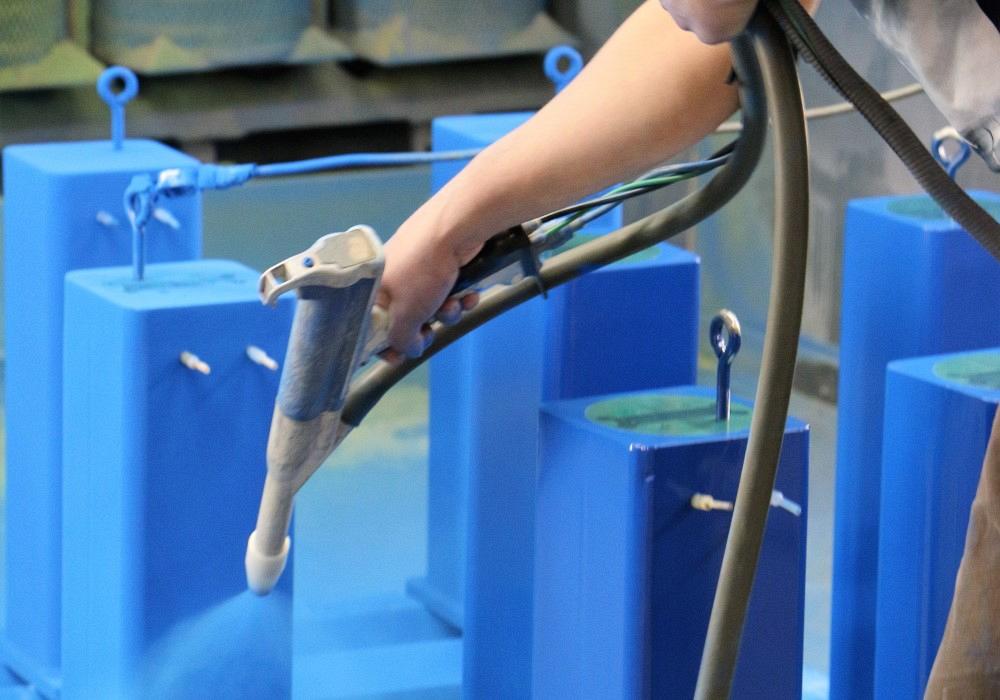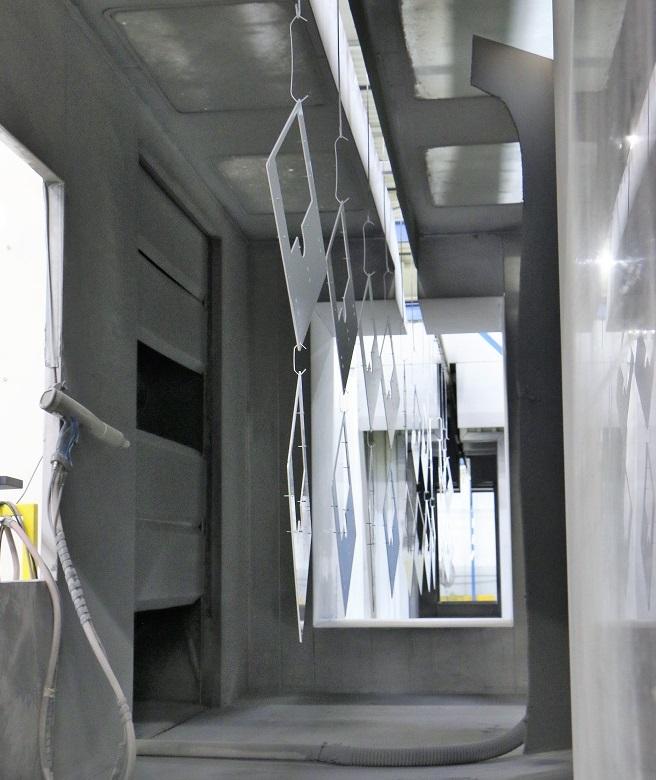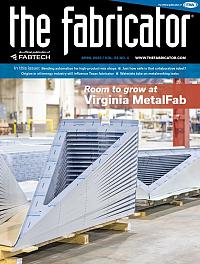President
- FMA
- The Fabricator
- FABTECH
- Canadian Metalworking
Categories
- Additive Manufacturing
- Aluminum Welding
- Arc Welding
- Assembly and Joining
- Automation and Robotics
- Bending and Forming
- Consumables
- Cutting and Weld Prep
- Electric Vehicles
- En Español
- Finishing
- Hydroforming
- Laser Cutting
- Laser Welding
- Machining
- Manufacturing Software
- Materials Handling
- Metals/Materials
- Oxyfuel Cutting
- Plasma Cutting
- Power Tools
- Punching and Other Holemaking
- Roll Forming
- Safety
- Sawing
- Shearing
- Shop Management
- Testing and Measuring
- Tube and Pipe Fabrication
- Tube and Pipe Production
- Waterjet Cutting
Industry Directory
Webcasts
Podcasts
FAB 40
Advertise
Subscribe
Account Login
Search
Finding the best custom coater for fabricated metal parts
3 critical factors can help metal fabrication shops narrow the search
- By Korey Bell
- April 25, 2023
- Article
- Finishing

A batch powder coating setup is most likely best for large weldments. Finding out the type of coating equipment the custom coater has is another way to determine if that company is the right fit.
The quality of coating shops, as with any other type of manufacturing shop, runs the gamut in terms of finish and service. So, how do fabricators choose from the many options available when selecting a shop to handle their finishing needs?
Last but Not Least
Satisfied customers keep a company in business, so it’s important not to overlook the aspect of finishing. The coating system—that is, part cleaning and pretreatment, powder or paint application, and curing—applied to your part is an integral piece of the puzzle in ensuring that your customers’ requirements are met and their satisfaction achieved.
Even if the components you fabricate are structurally perfect when delivered, your customer will not be happy if the applied coating falls off within months, leaving the components susceptible to corrosion.
Let’s take a look at three factors that you, the fabricator, can evaluate when selecting a custom coater for your next job.
1. Certifications
A quick way to judge the quality provided by a custom coater is by the certifications it holds. In the finishing world, there are quite a few certifications, approvals, and verifications. Which of these quality achievements is most relevant depends on customer requirements, including factors like part exposure to sun, water, and corrosives.
The most common quality certification, ISO 9001, encompasses the entire organization and requires companies to have an established and continually improving quality management system. Maintaining ISO certification, especially over a long period of time, is a leading indicator that a custom coater is going about its processes correctly. Keep in mind, though, that ISO 9001 is not specific to the coating system.
If your coated part will be exposed to environmental elements, look for a coater with American Architectural Manufacturers Association (AAMA) verification. There are three types of AAMA ratings—2603, 2604, and 2605—that indicate the performance grade of the coating. The specifics of each rating can be found through the Fenestration & Glazing Industry Alliance, but in general terms, the higher the number, the more resistant the coating is to fading, flaking, and corrosion.
If an AAMA-verified custom coater sounds like the right fit for you, the next step is to see if that coater is certified for application by the coatings manufacturer. To achieve this certification, which is specific to AAMA-compliant coatings, typically the custom coater must pass part performance testing that focuses on consistent final part specifications and compliance.
OEMs often have their own certifications related to finishing. Most require part performance testing as well as a facility visit and an audit focused on their particular requirements. So, if the parts you need coated will ultimately go to an OEM, you might check to see if that OEM has a coating certification and then choose a compliant coater.
If you are looking for a powder coater, another desirable certification is PCI 3000, administered by the Powder Coating Institute. To achieve this certification, a coater must pass a third-party audit that analyzes the entire company, with a focus on powder coating processes and procedures. Evaluated competencies include incoming quality control, pretreatment, application area, ovens and curing, training, maintenance, process control, final quality control, and loading/unloading and packaging. Coaters that attain this certification demonstrate they can produce a high-quality powder-coated part. To maintain certification, they must participate in regular maintenance audits and an on-site audit every three years.

If a metal fabricator doesn’t provide coating specifications when they are seeking bids for a job, it might wind up with quotes that differ greatly in cost. Because different custom coaters have different equipment, all quotes are not the same. A follow-up call with the custom coater might be necessary.
2. Coating System and Specifications
There are many coating specifications that might apply to parts you are fabricating. These specs will tell the custom coater exactly what should be done and how it is supposed to process your part. However, if you don’t provide a coating spec with your request for quote (RFQ), you may wind up with drastically different quotes—and results, depending on the custom coater you send it to.
For instance, there are many options for pretreatment and primer coatings. While the completed part might look the same when you first receive it back from the coater, the application or lack of pretreatment and primer steps can drastically affect the longevity of the coating system applied.
Perhaps you’ve sent out a RFQ for 200 linear feet of wrought-iron fencing to two different powder coating job shops. Shop A quotes you $18 per linear foot and shop B quotes the same job at $36 per linear foot. If you’re unfamiliar with powder coating, you might instantly dismiss Shop B, but that would be a mistake. It’s important to dig deeper and compare the coating systems being quoted rather than just the price.
Shop A, in this example, may be quoting you an iron phosphate wash followed by a single-step polyester topcoat. While the railings may look nice when you first get them back, this coating system will not survive long-term field use. Shop B quoted a far superior coating system that includes sandblasting, iron phosphate wash, epoxy primer, and finally an AAMA 2604-grade topcoat. This coating system is far superior to what was proposed by Shop A and will have a significantly longer lifespan in the field.
Don’t be afraid to question the coating system being quoted by the custom coater. A good coater will be able to explain what it’s recommending and why. If the coater providing you a quote cannot explain why it designed the coating system the way it did, find a different coater. It is critical that the necessary steps be taken before that final topcoat is applied to ensure long-term durability and end user satisfaction.
3. Equipment
The third factor to consider in your search for a custom coater is the equipment that will be used to process your job. Custom coaters might use a variety of washers, booths, and ovens to process parts. This equipment varies both in the size of the parts it can accommodate and the way the parts flow through the system.
Small quantities of large frames or weldments often are best served by a batch coating system with appropriately sized wash bays, booths, and ovens, while high-volume runs of small widgets would run much faster and more smoothly on a conveyorized coating line. While you can certainly process small parts in a batch system, and conveyor lines often can handle larger parts, selecting the best equipment for the job will result in lower costs, quicker lead times, and higher quality.
Keep the Customer Satisfied
As a fabricator, your responsibility doesn’t end with your process. If you are subcontracting coating out to a custom coating shop, it’s important to do your homework and make sure you are selecting the best coating shop to serve your needs.
Look for shops that are certified, are quoting the correct coating system for the job, and have the correct equipment on which to process it. The coating shop you select can make or break the satisfaction level of your customer and the end user. Do not take its selection lightly.
About the Author
Related Companies
subscribe now

The Fabricator is North America's leading magazine for the metal forming and fabricating industry. The magazine delivers the news, technical articles, and case histories that enable fabricators to do their jobs more efficiently. The Fabricator has served the industry since 1970.
start your free subscription- Stay connected from anywhere

Easily access valuable industry resources now with full access to the digital edition of The Fabricator.

Easily access valuable industry resources now with full access to the digital edition of The Welder.

Easily access valuable industry resources now with full access to the digital edition of The Tube and Pipe Journal.
- Podcasting
- Podcast:
- The Fabricator Podcast
- Published:
- 04/16/2024
- Running Time:
- 63:29
In this episode of The Fabricator Podcast, Caleb Chamberlain, co-founder and CEO of OSH Cut, discusses his company’s...
- Trending Articles
Tips for creating sheet metal tubes with perforations

Supporting the metal fabricating industry through FMA

JM Steel triples capacity for solar energy projects at Pennsylvania facility

Are two heads better than one in fiber laser cutting?

Fabricating favorite childhood memories

- Industry Events
16th Annual Safety Conference
- April 30 - May 1, 2024
- Elgin,
Pipe and Tube Conference
- May 21 - 22, 2024
- Omaha, NE
World-Class Roll Forming Workshop
- June 5 - 6, 2024
- Louisville, KY
Advanced Laser Application Workshop
- June 25 - 27, 2024
- Novi, MI


























